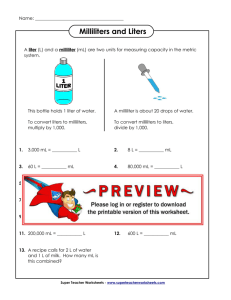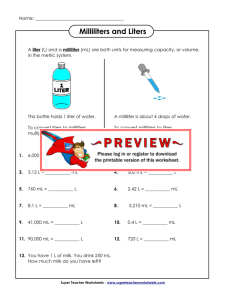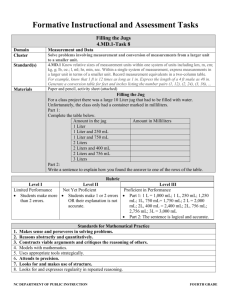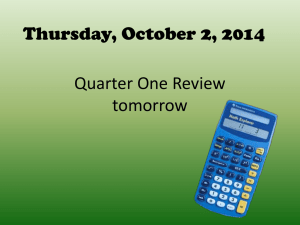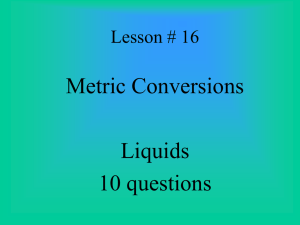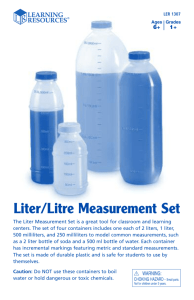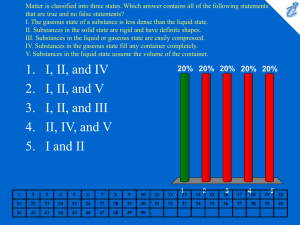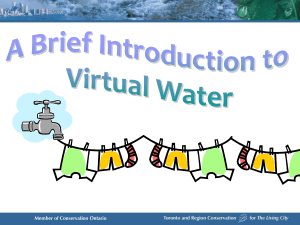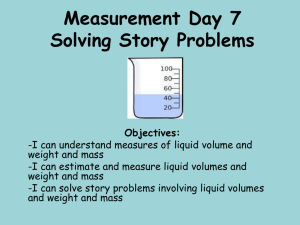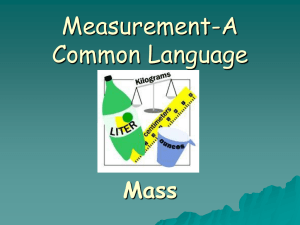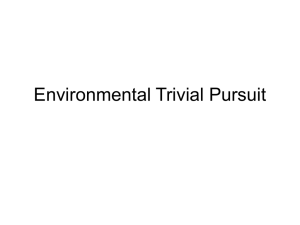Measuring Volume
advertisement
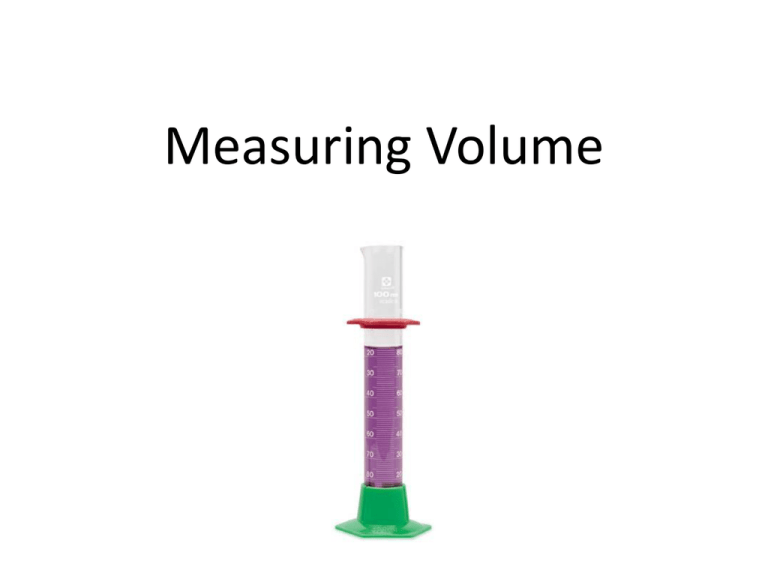
Measuring Volume What is Volume? • Volume is the amount of space an object takes up. • Volume can be used to directly measure liquids usually with a beaker or graduated cylinder, or with a formula to measure the volume of solids. • Formula for measuring volume in solids: • V=LxWxH Metric Units of Volume Measurement Liquids • Liter (L) – Unit of measurement (starting point) • Milliliter (ml) – (1 thousandth of a liter, 0.001, 10-3) • Centiliter (cl) – (1 hundredth of a liter, 0.01, 10-2) • Deciliter (dl) – (1 tenth of a liter, 0.1, 10-1) • Decaliter (dal) – (ten liters, 10, 101) • Hectoliter (hl) – (1 hundred liters, 100, 102) • Kiloliter(kl) – (1 thousand liters, 1000, 103) Solids • Cubic centimeters (cc, cm³) Volume of irregular shaped solid objects • Irregular shaped objects can be measured by: – Putting the object in water and measuring the amount of water displaced. – Finding the difference between the volume of water and the total volume of the water and the object. • The units deciliter, decaliter and hectoliter are not used as much as the other units. • liters are used to measure the capacity of larger things such as pitchers and aquariums • Kiloliters are used to measure the capacity of even larger things like swimming pools. Metric Conversions • To convert larger units to smaller ones , you MULTIPLY by units of 10 • To convert smaller units to larger ones you DIVIDE by units of 10 – Example: 1000 100 10 1 0.1 0.01 0.001 kiloliter hectoliter decaliter Unit (Liter) deciliter centiliter milliliter – To convert 8 Liters to centiliters (1 hundredth of a liter), you multiply by 100: • 8 x 100 = 800 cL (8 liters = 800 centiliters) – To convert 6 milliliters (1 thousandth of a liter) to liters, you divide by 1000 • 6 ÷ 1000 = 0.006 L (6 milliliters = 0.006 L) OR • Find out how far apart the two prefixes are on the line above. For example, kilo and hecto are one place apart, kilo and deka are two places apart, etc. • Move the decimal point to the left to convert smaller units or right to convert larger units by the number of places you found in the previous step. If there is no decimal in the number, assume it's after the last digit in the number. 1000 kiloliter 100 hectoliter 10 decaliter 1 Units (liters) 0.1 deciliter 0.01 Centiliter 0.001 milliliter Example #1 • To convert 1 kiloliter to liters (convert larger to smaller), move the decimal 1 place to the RIGHT and add zeros where needed for the number of places you move down the table. Decimal Point Start 1 kiloliter 0 hectoliter 0 decaliter • 1 kiloliter = 1000 liters End 0 liter deciliter Centiliter milliliter Example #2 • To convert 1 milliliters to liters (convert smaller to larger), move the decimal 1 place to the LEFT and add zeros where needed for the number of places you move down the table. Decimal Point End kiloliter hectoliter decaliter • 1 milliliter = 0.001 liters liter 0 deciliter 0 Centiliter Start 1 milliliter Convert the following measurements • 12 liters to centiliters 1200 cl ________ • 3 kiloliters to liters 3000 L _________ • 22 liters to milliliters 22000 ml _________ • 5 centiliters to liters 0.05 L _________ • 8 deciliters to liters 0.8 L _________ • 7 milliliters to deciliters 0.07 dl _________ How to Measure Volume We will be using graduated cylinders to find the volume of liquids and other objects. Read the measurement based on the bottom of the meniscus or curve. When using a real cylinder, make sure you are eye-level with the level of the water. What is the volume of water in this cylinder? _____mL 43 What causes the meniscus? A concave meniscus occurs when the molecules of the liquid attract those of the container. The glass attracts the water on the sides. What is the volume of water in each cylinder in milliliters? NOTE: Pay attention to the scales for each cylinder. 37 ml 52 ml 22.5 ml Images created at http://www.standards.dfes.gov.uk/primaryframework/downloads/SWF/measuring_cylinder.swf Measuring Liquid Volume Measuring Solid Volume 9 cm We can measure the volume of regular object using the formula length x width x height. 8 cm 10 X _____ 8 X _____ 9 = ________ 720 cm³ _____ 10 cm We can measure the volume of irregular object using water displacement. ml Amount of H2O with object = 260 ______ ml About of H2O without object = 200 ______ Difference = Volume = ______ 60 ml Using the beaker of water on your desk, measure out the following volumes in the graduated cylinder. (pour the water back into the beaker after each measurement). • • • • • • 20 ml 50 ml 6 ml 100 ml 13 ml 27 ml Find the volume of the following solid objects on your desk. (Tilt the cylinder and slide any solid object gently into it. DO NOT drop the object directly into the cylinder!) • Rock __________ • Small density cube __________ • Marble __________ • Paperclip __________
